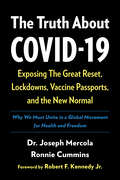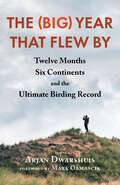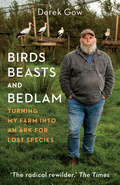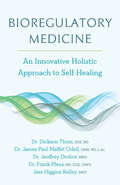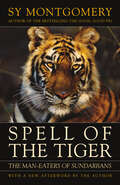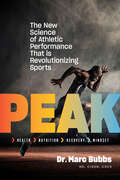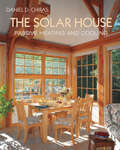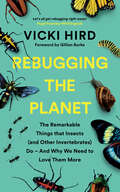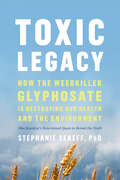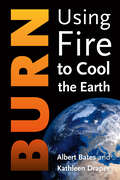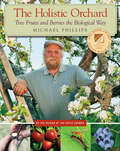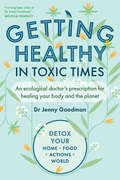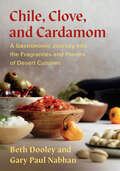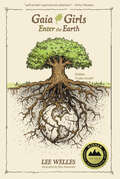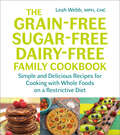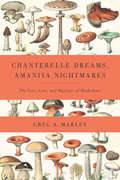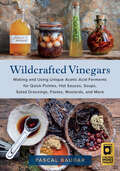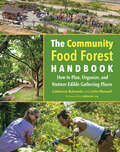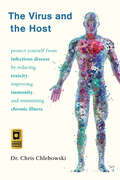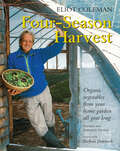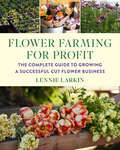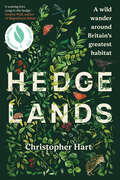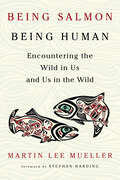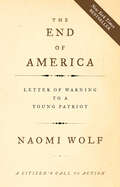- Table View
- List View
The Truth About COVID-19: Exposing The Great Reset, Lockdowns, Vaccine Passports, and the New Normal
by Joseph Mercola Ronnie CumminsUSA Today, Wall Street Journal, and Publishers Weekly National Bestseller&“An eloquent, charismatic, and knowledgeable [critique] of a corrupt system.&”—Robert F. Kennedy, Jr., from the foreword&“Dr. Mercola is a visionary, pioneer, and leader.&”—Del Bigtree, host of The HighwireMultiple New York Times best-selling author Dr. Joseph Mercola and Ronnie Cummins, founder and director of the Organic Consumers Association, team up to expose the truth—and end the madness—about COVID-19.Through vigorous research, over 500 references to peer-reviewed scientific journal articles, official government statistics, and public health research findings from around the world, the authors lay bare the urgent need for a global awakening. It is time to come together, demand the truth, and take control of our health. The Truth About COVID-19 is your invitation to join Dr. Mercola and Cummins as they educate and organize for a healthy, equitable, democratic, and regenerative future.*The Paperback Edition is Updated with a New Preface by Dr. Mercola*&“Phenomenal . . . required reading for this time in our lives.&”—Shawn Stevenson, host of The Model Health Show&“Dr. Mercola has changed the way we think about health.&”—Dave Asprey, New York Times bestselling author and host of Bulletproof Radio
The (Big) Year that Flew By: Twelve Months, Six Continents, and the Ultimate Birding Record
by Arjan Dwarshuis&“A fast-paced page-turner and a unique adventure story . . . filled with insights about landscapes, people, and a world of wonderful birds.&”―Kenn Kaufman, author of Kingbird HighwayAn epic tale of one passionate birder&’s record-breaking adventure through 40 countries over 6 continents—in just one year—to see 6,852 bird species, rare and common, before many go extinct.When Arjan Dwarshuis first heard of the &“Big Year&”—the legendary record for birdwatching—he was twenty years old, it was midnight, and he was sitting on the roof of a truck in the Andean Mountains. In that moment he promised himself that, someday, somehow, he would become a world-record-holding birder.Ten years later, he embarked on an incredible, arduous, and perilous journey that took him around the globe; over uninhabited islands, through dense unforgiving rainforests, across snowy mountain peaks and unrelenting deserts—in just a single year. Would he survive? Would he be able to break the &“Big Year&” record, navigating through a world filled with shifting climate and geopolitical challenges?The (Big) Year that Flew By is an unforgettable, personal exploration of the limits of human potential when engaging with the natural world. It is a book about birds and birding and Arjan&’s attempts to raise awareness for critically endangered species, but it is also a book about overcoming mental challenges, extreme physical danger, and human competition and fully realizing your passions through nature, adventure, and conservation.&“Dwarshius&’ exhilarating race against time across 40 countries and 6 continents in his attempt to break the world record will thrill armchair readers and bird enthusiasts alike.&”―Booklist&“I sped through [this] book, trying to ignore feelings of jealousy as Dwarshuis described moments with species I&’ve dreamed of seeing.&”—The Washington Post
Birds, Beasts and Bedlam: Turning My Farm into an Ark for Lost Species
by Derek Gow&“Courageous, visionary, funny.&”—Isabella Tree&“One of the most remarkable figures in British conservation.&”—Observer&“Gow reinvents what it means to be a guardian of the countryside.&”—GuardianBirds, Beasts and Bedlam recounts the adventures of Britain&’s favorite maverick rewilder, Derek Gow, and his single-minded mission to save our rarest wildlife—one species at a time.Author of Bringing Back the Beaver and Hunt for the Shadow Wolf, Derek shares his personal, courageous, and highly entertaining tales in Birds, Beasts and Bedlam, including how he raised a sofa-loving wild boar piglet, transported a raging bison bull across the UK, got bitten by a Scottish wildcat, and, together with Isabella Tree and Charlie Burrell, restored the ancient white stork to the pioneering Knepp Estate.After a Shetland ewe captured his heart as a boy, Derek grew up to become a farmer with a passion for ancient breeds. When he realized how many of our species were close to extinction—even on his own land—Derek tore down fences literally and metaphorically, transforming his traditional Devon farm into a 300-acre rewilding haven for beavers, water voles, lynx, wildcats, harvest mice, wild boar, and more. A project that is still ongoing today.Birds, Beasts and Bedlam continues the rich tradition of great British nature writing. Passionate, subversive, and unforgettable, it will leave you inspired to support rewilding efforts around the world, in your community, and even in your backyard.&“A do-er, not a dreamer, Gow has become one of our most outspoken rewilders.&”—Countryfile Magazine&“In this warm and funny autobiography, [Gow] writes with a whimsical fluency about the moments of humour and pathos in an unusual life.&”—Country Life&“Gow has a fire in his belly. We need more like him.&”―BBC Wildlife magazine&“[Gow&’s] stories can be bawdy, laugh-out-loud funny, poignant, or even depressing, but they&’re never dull.&”―Booklist
Bioregulatory Medicine: An Innovative Holistic Approach to Self-Healing
by Jess Higgins Kelley Dickson Thom James Paul Odell Jeoffrey Drobot Frank PleusOver half of the world&’s population is afflicted with some form of chronic or degenerative illness. Heart disease, autoimmune disease, diabetes, neurological conditions, cancer, Lyme disease—the list goes on. The conventional, allopathic, treat-the-symptom-with-pharmaceutical-drugs model is rapidly falling out of favor as patients are searching for nontoxic, advanced prevention and healing modalities that actually work. Bioregulatory Medicine introduces a model that has proven effective for decades in other more forward-thinking developed countries, including Switzerland and Germany.Our bodies have many bioregulating systems, including the cardiovascular, digestive, neurological, respiratory, endocrine, and so on. Bioregulatory medicine is a comprehensive and holistic approach to health that advocates the use of natural healing methods to support and restore the body&’s intrinsic self-regulating and self-healing mechanisms, as opposed to simply treating symptoms with integrative therapies. Bioregulatory medicine is about discovering the root cause of disease and takes into account the entire person from a genetic, epigenetic, metabolic, energetic, and emotional point of view. So while patients may have the same disease or prognosis, the manifestation of illness is entirely bioindividual and must be treated and prevented on an individual level.Bioregulatory Medicine addresses the four pillars of health—drainage and detox, diet, mind-body medicine, and oral health—using a sophisticated synthesis of the very best natural medicine with modern advances in technology. In addition to identifying the cause of disease, bioregulatory medicine promotes disease prevention and early intervention of illness through noninvasive diagnostics and treatments, and incorporates the use of over 100 different non-toxic diagnostics and treatments from around the world.Forward-thinking patients and integrative practitioners will find Bioregulatory Medicine invaluable as they seek to deepen their understanding of the body&’s many regulating systems and innate ability to heal itself.
Spell of the Tiger: The Man-Eaters of Sundarbans
by Sy MontgomeryFrom the author of The Soul of an Octopus and bestselling memoir The Good Good Pig, a book that earned Sy Montgomery her status as one of the most celebrated wildlife writers of our time, Spell of the Tiger brings readers to the Sundarbans, a vast tangle of mangrove swamp and tidal delta that lies between India and Bangladesh. It is the only spot on earth where tigers routinely eat people—swimming silently behind small boats at night to drag away fishermen, snatching honey collectors and woodcutters from the forest. But, unlike in other parts of Asia where tigers are rapidly being hunted to extinction, tigers in the Sundarbans are revered. With the skill of a naturalist and the spirit of a mystic, Montgomery reveals the delicate balance of Sundarbans life, explores the mix of worship and fear that offers tigers unique protection there, and unlocks some surprising answers about why people at risk of becoming prey might consider their predator a god.
Peak: The New Science of Athletic Performance That Is Revolutionizing Sports
by Marc BubbsAn integrated and personalized approach to health, nutrition, training, recovery, and mindsetPerfect for personal trainers, sports science students, fans of high level fitness (crossfit, marathon training, iron man, team sports) and gym heads!There is a new revolution happening in sports as more and more athletes are basing their success on this game-changing combination: health, nutrition, training, recovery, and mindset. Unfortunately, the evidence-based techniques that the expert PhDs, academic institutions, and professional performance staffs follow can be in stark contrast to what many athletes actually practice. When combined with the noise of social media, old-school traditions, and bro-science, it can be difficult to separate fact from fiction.Peak is a groundbreaking book exploring the fundamentals of high performance (not the fads), the importance of consistency (not extreme effort), and the value of patience (not rapid transformation). Dr. Marc Bubbs makes deep science easy to understand, and with information from leading experts who are influencing the top performers in sports on how to achieve world-class success, he lays out the record-breaking feats of athleticism and strategies that are rooted in this personalized approach.Dr. Bubbs’s performance protocol is for the elite athlete, active individual, strength coach, nutritionist, or practitioner who wants to expand their potential by:Connecting the importance of sleep, digestion, the athlete microbiome, and blood glucose control metricsCreating personalized deep nutrition strategies for building muscle, burning fat, or “making weight” for competitionRethinking nutrition specifically for team sportsLearning how elite endurance athletes fuel, including training techniques to boost performanceApplying the new science of recovery that enhances performanceEmphasizing the tremendous role of emotional intelligence and mindset in overcoming roadblocks and achieving athletic success (the next frontier in performance)Analyzing the qualities of elite leaders and how to develop them authenticallyDr. Bubbs expertly brings together the worlds of health, nutrition, and exercise and synthesizes the salient science into actionable guidance. Regardless if you’re trying to improve your physique, propel your endurance, or improve your team’s record, looking at performance through this lens is absolutely critical for lasting success.
The Solar House: Passive Heating and Cooling
by Daniel D. ChirasPassive solar heating and passive cooling—approaches known as natural conditioning—provide comfort throughout the year by reducing, or eliminating, the need for fossil fuel. Yet while heat from sunlight and ventilation from breezes is free for the taking, few modern architects or builders really understand the principles involved.Now Dan Chiras, author of the popular book The Natural House, brings those principles up to date for a new generation of solar enthusiasts.The techniques required to heat and cool a building passively have been used for thousands of years. Early societies such as the Native American Anasazis and the ancient Greeks perfected designs that effectively exploited these natural processes. The Greeks considered anyone who didn't use passive solar to heat a home to be a barbarian!In the United States, passive solar architecture experienced a major resurgence of interest in the 1970s in response to crippling oil embargoes. With grand enthusiasm but with scant knowledge (and sometimes little common sense), architects and builders created a wide variety of solar homes. Some worked pretty well, but looked more like laboratories than houses. Others performed poorly, overheating in the summer because of excessive or misplaced windows and skylights, and growing chilly in the colder months because of insufficient thermal mass and insulation and poor siting.In The Solar House, Dan Chiras sets the record straight on the vast potential for passive heating and cooling. Acknowledging the good intentions of misguided solar designers in the past, he highlights certain egregious—and entirely avoidable—errors. More importantly, Chiras explains in methodical detail how today's home builders can succeed with solar designs.Now that energy efficiency measures including higher levels of insulation and multi-layered glazing have become standard, it is easier than ever before to create a comfortable and affordable passive solar house that will provide year-round comfort in any climate.Moreover, since modern building materials and airtight construction methods sometimes result in air-quality and even toxicity problems, Chiras explains state-of-the-art ventilation and filtering techniques that complement the ancient solar strategies of thermal mass and daylighting. Chiras also explains the new diagnostic aids available in printed worksheet or software formats, allowing readers to generate their own design schemes.
Rebugging the Planet: The Remarkable Things that Insects (and Other Invertebrates) Do And Why We Need to Love Them More
by Vicki Hird"This is a lovely little book that could and should have a big impact...Let&’s all get rebugging right away!"—Hugh Fearnley-WhittingstallMeet the intelligent insects, marvelous minibeasts, and inspirational invertebrates that help shape our planet—and discover how you can help them help us by rebugging your attitude today!Remember when there were bugs on your windshield? Ever wonder where they went? We need to act now if we are to help the insects survive. Robin Wall Kimmerer, David Attenborough, and Elizabeth Kolbert are but a few voices championing the rewilding of our world. Rebugging the Planet explains how we are headed toward &“insectageddon&” with a rate of insect extinction eight times faster than that of mammals or birds, and gives us crucial information to help all those essential creepy-crawlies flourish once more.Author Vicki Hird passionately demonstrates how insects and invertebrates are the cornerstone of our global ecosystem. They pollinate plants, feed birds, support and defend our food crops, and clean our water systems. They are also beautiful, inventive, and economically invaluable—bees, for example, contribute an estimated $235 to $577 billion to the US economy annually, according to Forbes.Rebugging the Planet shows us small changes we can make to have a big impact on our littlest allies:• Learn how to rewild parks, schools, sidewalks, roadsides, and other green spaces.• Leave your garden to grow a little wild and plant weedkiller-free, wildlife-friendly plants.• Take your kids on a minibeast treasure hunt and learn how to build bug palaces.• Make bug-friendly choices with your food and support good farming practices• Begin to understand how reducing inequality and poverty will help nature and wildlife too—it&’s all connected.So do your part and start rebugging today! The bees, ants, earthworms, butterflies, beetles, grasshoppers, ladybugs, snails, and slugs will thank you—and our planet will thank you too.
The Resilient Gardener: Food Production and Self-Reliance in Uncertain Times
by Carol Deppe"The Resilient Gardener is so essential, timely and important, and I will recommend it to everyone I know. It doesn't matter if you garden or if you don't-this is practical wisdom good for humans to know."—Deborah Madison, Author of Local Flavors and Vegetarian Cooking for EveryoneScientist/gardener Carol Deppe combines her passion for organic gardening with newly emerging scientific information from many fields — resilience science, climatology, climate change, ecology, anthropology, paleontology, sustainable agriculture, nutrition, health, and medicine. In the last half of The Resilient Gardener, Deppe extends and illustrates these principles with detailed information about growing and using five key crops: potatoes, corn, beans, squash, and eggs.In this book you&’ll learn how to:•Garden in an era of unpredictable weather and climate change•Grow, store, and use more of your own staple crops•Garden efficiently and comfortably (even if you have a bad back)•Grow, store, and cook different varieties of potatoes and save your own potato seed•Grow the right varieties of corn to make your own gourmet-quality fast-cooking polenta, cornbread, parched corn, corn cakes, pancakes and even savory corn gravy•Make whole-grain, corn-based breads and cakes using the author&’s original gluten-free recipes involving no other grains, artificial binders, or dairy products•Grow and use popbeans and other grain legumes•Grow, store, and use summer, winter, and drying squash•Keep a home laying flock of ducks or chickens; integrate them with your gardening, and grow most of their feed.The Resilient Gardener is both a conceptual and a hands-on organic gardening book, and is suitable for vegetable gardeners at all levels of experience. Resilience here is broadly conceived and encompasses a full range of problems, from personal hard times such as injuries, family crises, financial problems, health problems, and special dietary needs (gluten intolerance, food allergies, carbohydrate sensitivity, and a need for weight control) to serious regional and global disasters and climate change. It is a supremely optimistic as well as realistic book about how resilient gardeners and their vegetable gardens can flourish even in challenging times and help their communities to survive and thrive through everything that comes their way — from tomorrow through the next thousand years. Organic gardening, vegetable gardening, self-sufficiency, subsistence gardening, gluten-free living."The Resilient Gardener is brilliantly timely, and shows us how to create gardens that can survive our increasingly erratic weather, while supplying key nutrition lacking in most vegetable gardens. This book fills a critical niche, and I recommend it unreservedly."—Toby Hemenway, author of Gaia's Garden: A Guide to Home-Scale Permaculture
Toxic Legacy: How the Weedkiller Glyphosate Is Destroying Our Health and the Environment
by Stephanie SeneffNamed a &“Best Book of the Year&” by Kirkus Reviews&“Urgent and eye-opening, the book serves as a loud-and-clear alarm.&”―The Boston GlobeNamed an &“Outstanding Academic Title&” by Choice From an MIT scientist, mounting evidence that the active ingredient in the world&’s most commonly used weedkiller is contributing to skyrocketing rates of chronic disease.Glyphosate is the active ingredient in Roundup, the most commonly used weedkiller in the world. Over 300 million pounds of glyphosate-based herbicide are sprayed on farms―and food―every year.Agrochemical companies claim that glyphosate is safe for humans, animals, and the environment. But emerging scientific research on glyphosate&’s deadly disruption of the gut microbiome, its crippling effect on protein synthesis, and its impact on the body&’s ability to use and transport sulfur―not to mention several landmark legal cases―tells a very different story.In Toxic Legacy, senior research scientist Stephanie Seneff, PhD, delivers compelling evidence based on countless published, peer-reviewed studies―all in frank, illuminating, and always accessible language.As Rachel Carson did with DDT in the 1960&’s with Silent Spring, Seneff sounds the alarm on glyphosate, giving you guidance on simple changes you can make right now and essential information you need to protect your health, your family&’s health, and the planet on which we all depend.&“A game-changer that we would be foolish to ignore.&”―Kirkus Reviews (starred)&“Toxic Legacy will stand shoulder to shoulder with Rachel Carson&’s Silent Spring. [This is] unquestionably, one of the most important books of our time.&”―David Perlmutter, MD, #1 New York Times bestselling author of Grain Brain&“Dr. Seneff&’s work will change the way we all think about food.&”―Mark Hyman, MD, New York Times bestselling author
Burn: Igniting a New Carbon Drawdown Economy to End the Climate Crisis
by Albert Bates Kathleen Draper&“A brilliant, climatic coup that uplifts biochar to an entirely new level of substance and urgency!&”―Paul HawkenHow we can harness carbon to help solve the climate crisis in order to rescue ourselves from climate catastropheIn order to rescue ourselves from climate catastrophe, we need to radically alter how humans live on Earth. We have to go from spending carbon to banking it. We have to put back the trees, wetlands, and corals. We have to regrow the soil and turn back the desert. We have to save whales, wombats, and wolves. We have to reverse the flow of greenhouse gases and send them in exactly the opposite direction: down, not up. We have to flip the carbon cycle and run it backwards. For such a revolutionary transformation we&’ll need civilization 2.0.A secret unlocked by the ancients of the Amazon for its ability to transform impoverished tropical soils into terra preta—fertile black earths—points the way. The indigenous custom of converting organic materials into long lasting carbon has enjoyed a reawakening in recent decades as the quest for more sustainable farming methods has grown. Yet the benefits of this carbonized material, now called biochar, extend far beyond the soil. Pyrolyzing carbon has the power to restore a natural balance by unmining the coal and undrilling the oil and gas. Employed to its full potential, it can run the carbon cycle in reverse and remake Earth as a garden planet.Burn looks beyond renewable biomass or carbon capture energy systems to offer a bigger and bolder vision for the next phase of human progress, moving carbon from wasted sources:• Into soils and agricultural systems to rebalance the carbon, nitrogen, and related cycles; enhance nutrient density in food; rebuild topsoil; and condition urban and agricultural lands to withstand flooding and drought• To cleanse water by carbon filtration and trophic cascades within the world&’s rivers, oceans, and wetlands• To shift urban infrastructures such as buildings, roads, bridges, and ports, incorporating drawdown materials and components, replacing steel, concrete, polymers, and composites with biological carbon• To drive economic reorganization by incentivizing carbon drawdownFully developed, this approach costs nothing—to the contrary, it can save companies money or provide new revenue streams. It contains the seeds of a new, circular economy in which energy, natural resources, and human ingenuity enter a virtuous cycle of improvement. Burn offers bold new solutions to climate change that can begin right now.An 800-CEO-READ "Editor's Choice" March 2019
The Holistic Orchard: Tree Fruits and Berries the Biological Way
by Michael PhillipsWinner of the American Horticulture Society Book Award&“Phillip&’s first-hand knowledge anchors this innovative and highly readable book in practical wisdom that both beginner and long-time fruit growers will find invaluable.&”—Toby Hemenway, author of Gaia&’s GardenMany people want to grow fruit on a small scale but lack the insight to be successful orchardists. As The Holistic Orchard illustrates, growing tree fruits and berries is something virtually anyone can do. A holistic grower knows that producing fruit is not about manipulating nature but more importantly, fostering nature.The Holistic Orchard demystifies the basic skills everybody should know about the orchard ecosystem, focusing on:Orchard designSoil biologyOrganic health managementGraftingPlantingPruningChoosing the right varieties for your climateIncludes a step-by-step instructional calendar to guide growers through the entire orchard year!Fruit profiles include:pome fruits (apples, pears, asian pears, quinces)stone fruits (cherries, peaches, nectarines, apricots, plums)berries (raspberries, blackberries, blueberries, gooseberries, currants, and elderberries)Phillips completely changed the conversation about healthy orcharding with his first bestselling book, The Apple Grower, and now he takes that dialogue even further by exploring:The connections between home orcharding and permacultureThe importance of native pollinatorsPlantings with shade-tolerant berry bushes and other insectary plantsInformation on cover crops and biodiversitySafe, homegrown solutions to pest and disease challengesAll along the way, Phillips&’ expertise and enthusiasm for healthy growing shines through, as does his ability to put the usual horticultural facts into an integrated ecology perspective. With The Holistic Orchard in your hand you have every reason in the world to confidently plant that very first—or next—fruit tree!
Getting Healthy in Toxic Times: An ecological doctor's prescription for healing your body and the planet
by Jenny GoodmanHow can we protect ourselves from the pollution, chemicals, and toxins that pervade our environment? Dr. Jenny Goodman connects the health of our planet with our own well-being, addressing the questions that very few doctors ask.We&’re all too aware of the traffic pollution in the air, the chemicals in our water, the toxins in the soil (and therefore our food), and the electromagnetic energy emanating from our gadgets.If we can also understand how they affect our health, not least in the worrying rises in asthma and allergies, infertility, obesity, heart disease, behavioral and neurological disorders, as well as cancer, then we can take positive steps to avoid them.With the right information, we can:• Safeguard ourselves with protective measures• Minimize our interactions with pollutants• Ensure our bodies have the right anti-toxin nutrients• Take collective action to fight for our health and that of the environmentBacked by the latest scientific and medical research, Getting Healthy in Toxic Times will empower you to look after your own health—and that of the planet. Let&’s put the good stuff in and take the bad stuff out!
Chile, Clove, and Cardamom: A Gastronomic Journey Into the Fragrances and Flavors of Desert Cuisines
by Gary Paul Nabhan Beth DooleyExplore mouth-watering recipes from the most vibrant and diverse culinary traditions of the hottest and driest places on earth—including the aromatic dishes and arid-adapted traditions from Central Asia, the Middle East, North Africa, and the deserts shared by the US and Mexico—compiled by two James Beard Award-winning writers.Chile, Clove, and Cardamom is a celebration of the fragrances and flavors of sun-drenched cuisines. Throughout this book, coauthors Beth Dooley and Gary Paul Nabhan reveal surprising patterns and principles among varied recipes of traditional desert cultures, bringing to life the places, dishes, and recipes that have been shaped by heat and drought and infused with bold flavors.Gary Paul Nabhan, world-renowned ethnobotanist, desert ecologist, and literary naturalist, has written extensively about foods from the Middle East to the desert Southwest and is the winner of the 2024 James Beard Media Award for his recent book Agave Spirit. Joined by fellow James Beard Award–winner (The Sioux Chef, 2018) and food writer Beth Dooley, who has explored both Indigenous and perennial foods, the two have created a unique, stunning collection of over 90 recipes that honor the tastiness of cuisines that have influenced how all of humanity eats today.Steeped in history and memory, Chile, Clove, and Cardamom is also a beautifully photographed, in-depth guide to the essential spice blends that will help you build your own aromatic pantry, drawing on a variety of easy-to-follow cooking methods for planning your own desert meals.Inside, you&’ll find:Main Dishes: Sticky Lamb Ribs, Spicy Orange Chicken, Roast Chicken with Tarragon and Capers, Stuffed Mexican Peppers in Yogurt Walnut Sauce, and Lamb Kebabs with Moroccan Spices and Pomegranate Molasses Glaze.Light Fare and Small Plates: Squash Blossom Fritters, Sonoran Flat Enchiladas, and Eggplant Fries with Desert Syrup.Dips and Sauces: Sonoran Tepary Dip, Fire Roasted Eggplant Tahini Dip, Aromatic Red Pepper Sauce, and Fig and Pomegranate Jam.Breads: Pocket Flat Breads, Pan de Semita, and Blue Corn Bread.Soups and Stews: Tunisian Chickpea Stew, White Bean Chili, and Watermelon and Cactus Fruit Gazpacho.Salads: Desert Succotash, Za&’atar-Roasted Cauliflower, and Tangerine and Radish Salad.Drinks and Desserts: Pineapple Sotol Margarita, Canary Islands Pastries, and Phyllo Nut Pinwheels.As hotter and drier conditions become more familiar to people beyond the places where these Indigenous and Nomadic cultural cuisines originated, these water-conserving dishes and energy-saving techniques become timely for many of us. Each recipe, in turn, introduces us to the gastronomic legacies that connect these cuisines, offering tips for understanding and sourcing high-quality, delicious ingredients—and how to use them—in a changing world.&“If all the world&’s most delicious foods had a reunion, this would be their family album.&”—Lawrence Downes, writer; former member of the New York Times editorial board
Gaia Girls Enter the Earth
by Lee WellesElizabeth Angier was happy to be at the end of the school year. She thought her summer on the family farm would be full of work and play with her best friend, Rachel, and her other best friend, her dog, Maizey. However, Elizabeth didn't anticipate the Harmony Farms Corporation moving to her town. Her world starts to crumble as her best friend moves away and her parents whisper of farmers selling their land and the effects this factory farm operation could have on them. When she thinks things can't get much worse, she meets the most unusual creature, Gaia, the living entity of the Earth. Strange things begin to happen to her, around her, and through her! Elizabeth discovers that with these new powers comes responsibility. A dire mistake makes Elizabeth wonder if meeting Gaia has been a blessing or a curse. Will Elizabeth have the strength to fight a large corporation? Or will her upstate New York home be spoiled by profit driven pork production that fouls the air, land, and water?
The Grain-Free, Sugar-Free, Dairy-Free Family Cookbook: Simple and Delicious Recipes for Cooking with Whole Foods on a Restrictive Diet
by Leah WebbIncludes one month of deeply nutritious, kid-friendly, whole foods recipes, meal plans, and detailed shopping lists to make life easier! &“Informative and user-friendly. . . . the dishes are beautifully and simply photographed, and recipes are uncomplicated and attainable . . . . As a mother with a passion for delicious and healthy food I found this book inspiring.&”—Natural Medicine Journal&“This is a must-read for anyone involved in the health and well-being of children! It&’s valuable information we all need to hear.&”—Hilary Boynton, author of The Heal Your Gut CookbookThe Grain-Free, Sugar-Free, Dairy-Free Family Cookbook offers a new system to preparing food and approaching the kitchen that gets kids involved in cooking, encouraging excitement around food (a major challenge with restrictive diets). The recipes are rich in healthy fats, nutrient-dense vegetables, ferments, and grass-fed meats, and include snacks, school lunches, and delicious sweet treats that rival the flavors of sugar-dense desserts. By following Leah&’s meal plans, parents will be sure to please everyone in the family and make cooking on a restrictive diet enjoyable and doable over a long period of time. Families that know they would like to rid themselves of grain, sugar, and dairy, but are intimidated by starting, will find Webb&’s advice and troubleshooting invaluable.Recipes include:Breakfasts and &“breads&”Main coursesVegetable sides and saladsSoups and stewsSnacksSauces, dips, and dressingsSmoothies and other drinksFermentsSweet TreatsThe cookbook outlines family-tested methods that make for effective and efficient preparation, including everyday basic recipes that will become part of a cook&’s intuitive process over time. The best part is that although Leah prepares nearly every single one of her family&’s breakfasts, lunches, dinners, and snacks using whole food ingredients, she only spends four to six hours on food preparation per week! Through stocking her freezer, prepping the kitchen, shopping and cooking in bulk, and consistently planning meals, this diet plan is not only possible; it is manageable and fulfilling.Prepare for this cookbook to radically change your life!
Chanterelle Dreams, Amanita Nightmares: The Love, Lore, and Mystique of Mushrooms
by Greg Marley*Winner, International Association of Culinary Professionals Jane Grigson Award*Finalist, International Association of Culinary Professionals in the Culinary History categoryThroughout history, people have had a complex and confusing relationship with mushrooms. Are fungi food or medicine, beneficial decomposers or deadly &“toadstools&” ready to kill anyone foolhardy enough to eat them? In fact, there is truth in all these statements. In Chanterelle Dreams, Amanita Nightmares, author Greg Marley reveals some of the wonders and mysteries of mushrooms, and our conflicting human reactions to them.With tales from around the world, Marley, a seasoned mushroom expert, explains that some cultures are mycophilic (mushroom-loving), like those of Russia and Eastern Europe, while others are intensely mycophobic (mushroom-fearing), including, the US. He shares stories from China, Japan, and Korea-where mushrooms are interwoven into the fabric of daily life as food, medicine, fable, and folklore-and from Slavic countries where whole families leave villages and cities during rainy periods of the late summer and fall and traipse into the forests for mushroom-collecting excursions.From the famous Amanita phalloides (aka &“the Death Cap&”), reputed killer of Emperor Claudius in the first century AD, to the beloved chanterelle (cantharellus cibarius) known by at least eighty-nine different common names in almost twenty-five languages, Chanterelle Dreams, Amanita Nightmares explores the ways that mushrooms have shaped societies all over the globe.This fascinating and fresh look at mushrooms-their natural history, their uses and abuses, their pleasures and dangers-is a splendid introduction to both fungi themselves and to our human fascination with them. From useful descriptions of the most foolproof edible species to revealing stories about hallucinogenic or poisonous, yet often beautiful, fungi, Marley&’s long and passionate experience will inform and inspire readers with the stories of these dark and mysterious denizens of our forest floor.
Wildcrafted Vinegars: Making and Using Unique Acetic Acid Ferments for Quick Pickles, Hot Sauces, Soups, Salad Dressings, Pastes, Mustards, and More
by Pascal Baudar*2022 Foreword INDIES Book of the Year Award Silver Winner for CookingAward-winning author and forager Pascal Baudar uncovers incredible flavors and inspiring recipes to create unique, place-based vinegars using any landscape.Includes more than 100 delicious, easy recipes for quick pickles, soups, sauces, salad dressings, beverages, desserts, jams, and more!&“[Wildcrafted Vinegars] celebrates the versatility of this all-important—but often overlooked—acid in the kitchen.&”—Plate MagazineAfter covering yeast fermentation (The Wildcrafting Brewer) and lactic acid fermentation (Wildcrafted Fermentation), pioneering food expert Pascal Baudar completes his wild fermentation trilogy by tackling acetic acid ferments and the wide array of dishes you can create with them. Baudar delves deeply into the natural world for wild-gathered flavors: herbs, fruits, berries, roots, mushrooms—even wood, bark, and leaves—that play a vital part in infusing distinctive gourmet-quality vinegars.More than 100 recipes show how to use homemade vinegars to make a wide range of delicious foods: quick pickles, soups, sauces, salad dressings, beverages, desserts, jams, and other preserves.Recipes include:Pine, fir, and spruce–infused vinegarSmoked mushroom and seaweed vinegarBlueberry-mugwort vinegarWilder curry vinaigretteWasabi ginger vinegar saucePickled walnutsMountain oxymelAnd many more!Once you&’ve mastered the basic methods for making and aging vinegars at home, you might be inspired to experiment on your own and find local plants that express the unique landscape and terroir wherever you happen to live. Or you might decide to forage for ingredients in your own garden or at a local farmers market instead. Either way, Pascal Baudar is an experienced and encouraging guide to safe and responsible wild-gathering and food preservation.&“Pascal Baudar is a culinary visionary.&”—Sandor Ellix Katz, author of The Art of Fermentation
The Community Food Forest Handbook: How to Plan, Organize, and Nurture Edible Gathering Places
by Catherine Bukowski John MunsellCollaboration and leadership strategies for long-term successFueled by the popularity of permaculture and agroecology, community food forests are capturing the imaginations of people in neighborhoods, towns, and cities across the United States. Along with community gardens and farmers markets, community food forests are an avenue toward creating access to nutritious food and promoting environmental sustainability where we live. Interest in installing them in public spaces is on the rise. People are the most vital component of community food forests, but while we know more than ever about how to design food forests, the ways in which to best organize and lead groups of people involved with these projects has received relatively little attention.In The Community Food Forest Handbook, Catherine Bukowski and John Munsell dive into the civic aspects of community food forests, drawing on observations, group meetings, and interviews at over 20 projects across the country and their own experience creating and managing a food forest. They combine the stories and strategies gathered during their research with concepts of community development and project management to outline steps for creating lasting public food forests that positively impact communities.Rather than rehash food forest design, which classic books such as Forest Gardening and Edible Forest Gardens address in great detail, The Community Food Forest Handbook uses systems thinking and draws on social change theory to focus on how to work with diverse groups of people when conceiving of, designing, and implementing a community food forest. To find practical ground, the authors use management phases to highlight the ebb and flow of community capitals from a project&’s inception to its completion. They also explore examples of positive feedbacks that are often unexpected but offer avenues for enhancing the success of a community food forest.The Community Food Forest Handbook provides readers with helpful ideas for building and sustaining momentum, working with diverse public and private stakeholders, integrating assorted civic interests and visions within one project, creating safe and attractive sites, navigating community policies, positively affecting public perception, and managing site evolution and adaptation. Its concepts and examples showcase the complexities of community food forests, highlighting the human resilience of those who learn and experience what is possible when they collaborate on a shared vision for their community.&“A highly useful guide based on the collective wisdom of people and communities who are defining this practice as they develop it on the ground. The thoughtful analysis of planning strategies and numerous case studies of active projects help us all understand what community food forests are and can be for the future.&”—Steve Gabriel, author of Silvopasture and coauthor of Farming the Woods
The Virus and the Host: Protect Yourself from Infectious Disease by Reducing Toxicity, Improving Immunity, and Minimizing Chronic Illness
by Chris Chlebowski"A gem of a book at a timely moment in history."—Stephanie Seneff, author of Toxic LegacyLearn how to take control of your health—and decrease susceptibility to infectious viral disease before it strikes.There will almost certainly be more pandemics in our future. Yet, during the coronavirus crisis, not a single major public health official took the simple step of telling Americans what we all need to hear:Robust good health—healthy immunity, low inflammation, low toxic burden, and freedom from stealth infection and chronic disease—is our best defense against infectious viral disease.Of course, it&’s not that simple. The way our bodies interact with infectious disease is complicated—both a function of the &“germ&” and the &“terrain&”—the virus and the host. In The Virus and the Host, Dr. Chlebowski succinctly describes emerging science on the virome and how toxic exposure, chronic inflammation, infections, and chronic diseases interact and predispose us to poor outcomes from acute viral infection. He then clearly outlines the tools needed for better health, including:• How to eat like your life depends on it• The best nutrients to supercharge your immunity• How to harness the power of botanical medicine• How to detoxify simply and safely at home• Valuable information on simple treatment and recommended diagnostic tests for given conditionsAs we move forward from the tragedy of COVID-19, it is essential that we come together to learn from our mistakes, and work hard—and work together—to prevent a similar crisis in the future. When the next pandemic hits, we need to be better prepared. Now is the time to do something, and it is the best investment we can make so that when—not if—the next &“big one&” hits we can keep our loved ones and ourselves safe and healthy. "This book left me feeling optimistic and empowered, and gave me greater knowledge about the history of viruses, as well as their future.&”—Erin Elizabeth, author; public speaker; founder, Health Nut News 2022 Foreword INDIES Book of the Year Award Finalist for Health
Four-Season Harvest: Organic Vegetables from Your Home Garden All Year Long, 2nd Edition
by Eliot Coleman&“Eliot is the reason I&’m cooking. . . . I&’ve followed that path because Eliot made it possible, and exciting, to farm in the four seasons.&”—Dan Barber, chef&“There is hardly a more well-known or well-respected name among organic farmers than Eliot Coleman.&”—Civil EatsLearn season-extending techniques and eat the best food—garden fresh and chemical free—all year long, with little effort or expense.If you love the joys of eating home-garden vegetables but always thought those joys had to stop at the end of summer, this book is for you. Eliot Coleman introduces the surprising fact that most of the United States has more winter sunshine than the south of France. He shows how North American gardeners can successfully use that sun to raise a wide variety of traditional winter vegetables in backyard cold frames and plastic covered tunnel greenhouses without supplementary heat.Inside, you&’ll also learn:Composting techniquesSimple Mineral AmendmentsPlanning and preparing your garden siteSeeds for four seasonsHow to build cold frames, high tunnels, and mobile greenhousesHow to cope with snowHow to create a root cellar and other storage techniquesAnd much, much more!Coleman expands upon his own experiences with new ideas learned on a winter-vegetable pilgrimage across the ocean to the acknowledged kingdom of vegetable cuisine, the southern part of France, which lies on the 44th parallel, the same latitude as his farm in Maine.This story of sunshine, weather patterns, old limitations and expectations, and new realities is delightfully innovative in the best gardening tradition. Four-Season Harvest will have you feasting on fresh produce from your garden all through the winter.&“The man, the farmer, the legend, is Eliot Coleman.&”—The AtlanticTo learn more about the possibility of a four-season farm, please visit Coleman&’s website www.fourseasonfarm.com.
Flower Farming for Profit: The Complete Guide to Growing a Successful Cut Flower Business
by Lennie LarkinNamed a &“Best Book for Budding Farmers&” by Country Living&“Flower Farming for Profit does a deep dive into the least glamorous, but most important part of farming—how to run a profitable business. This must-have book is incredibly thoughtful, well organized, and brimming with real-life examples. Lennie&’s down-to-earth, no-nonsense approach to the numbers is a breath of fresh air.&”—Erin Benzakein, owner, Floret Farm; New York Times bestselling author of Floret Farm&’s A Year in FlowersWith practical, step-by-step instructions and on-the-ground examples at every scale, Flower Farming for Profit is a comprehensive, beautiful guide to achieving profitability as a cut flower farmer.When Lennie Larkin set out to become a flower farmer, she found all sorts of resources about growing flowers but a scarcity of reliable information on how to build a profitable cut flower business. How do you create efficient systems and adequately value your own time and effort through your pricing? When and how should you consider scaling up your farm? How can you make doing what you love support you financially?In Flower Farming for Profit, Larkin answers these questions—and many, many more. With instructive lessons and savvy business tips from her own and other successful farms around the world, she explores:The diverse challenges of both wholesale and retail sales channels, from florists and farm stands to farmers marketsStreamlining weddings for the farmer-florist, from communications to floral designEfficient recordkeeping and bookkeepingSteps for conducting your own cost-of-production analysisMarketing and growth strategiesBusiness planning, goal setting, and making financial projectionsCrop planning based on local climatic conditions, market demand, and sales projectionsThe cut flower industry continues to experience wild growth. To successfully do what they love while expanding the market for sustainably produced flowers, new and experienced farmers alike must deliberately step back from the field and into the office. Flower Farming for Profit is a one-of-a-kind guide to creating the type of numbers-driven business that will allow individual farms to prosper and local flower economies to thrive.
Hedgelands [US Edition]: A wild wander around Britains greatest habitat
by Christopher HartLonglisted for the James Cropper Wainwright Prize 2024 for Nature Writing"Delightful . . . Hedgelands is a merry exposition on the history and biology of these unique ecosystems, and a very good argument as to why we should re-engage with the hedge."—The Wall Street Journal"Hart&’s passion for the potential that resides here is intoxicating. Occasionally an environmental solution comes along that is so breathtakingly simple you can&’t believe that not everyone is already doing it."—Sunday Times"[A] joyously readable book— it riffs along like breeze in the hedgerow."—John Lewis-Stempel in Country LifeOn this joyous journey around the wild edges of Britain, celebrated author Christopher Hart takes us through the life, ecology and history of the humble countryside hedge and how it is inextricably woven into our language, landscape and culture.Hedges – or hedgerows – have long been an integral part of the British landscape. An ancient, human-made boundary, hedgerows have become a critically important haven for wildlife and are now being recognised as one of the greatest &‘edge&’ habitats on Earth.Britain boasts 400,000 kilometres of hedgerows, but has lost 50 per cent of them since the Second World War and their slow deterioration today is becoming a huge threat to the ecosystem.In Hedgelands, Christopher Hart shares the history of the hedge, highlighting the hawthorn and hazel of ancient hedgerows, and reveals its abundance of wildlife, from the elusive dunnock to the iconic nightingale, the industrious hedgehog to the miniscule harvest mouse.He demonstrates how this true environmental hero and powerful climate ally can help rebuild species-rich, resilient havens for birds, mammals and insects. Hedges play a vital role in mature woodland, grassland and even wetland, all of which can offer us much-needed ecological diversity and carbon sequestration.Through rewilding a patch of land in southwest England, Christopher shows us how easy, joyful and rewarding it is to restore even the smallest stretch of hedge. Whether you live in the country or the city, Hedgelands shares how simple actions can make a huge difference to the future of our precious hedges – and environment.&“What&’s good for us is good for nature, and what&’s good for nature is good for us. And nowhere is this more true than in the bustling, flourishing, flowering, fruiting and altogether glorious native British hedge.&”—Christopher Hart
Being Salmon, Being Human: Encountering the Wild in Us and Us in the Wild
by Martin Lee MuellerNautilus Award Silver Medal Winner, Ecology & Environment In search of a new story for our place on earthBeing Salmon, Being Human examines Western culture&’s tragic alienation from nature by focusing on the relationship between people and salmon―weaving together key narratives about the Norwegian salmon industry as well as wild salmon in indigenous cultures of the Pacific Northwest.Mueller uses this lens to articulate a comprehensive critique of human exceptionalism, directly challenging the four-hundred-year-old notion that other animals are nothing but complicated machines without rich inner lives and that Earth is a passive backdrop to human experience. Being fully human, he argues, means experiencing the intersection of our horizon of understanding with that of other animals. Salmon are the test case for this. Mueller experiments, in evocative narrative passages, with imagining the world as a salmon might see it, and considering how this enriches our understanding of humanity in the process.Being Salmon, Being Human is both a philosophical and a narrative work, rewarding readers with insightful interpretations of major philosophers―Descartes, Heidegger, Abram, and many more―and reflections on the human–Earth relationship. It stands alongside Abram&’s Spell of the Sensuous and Becoming Animal, as well as Andreas Weber&’s The Biology of Wonder and Matter and Desire―heralding a new &“Copernican revolution&” in the fields of biology, ecology, and philosophy.&“Philosophically, scientifically, morally, and artistically, Mueller blows the [salmon] industry guys literally out of the water. If you care about the future of salmon, you must read this essential, rigorously documented book.&”―Sy Montgomery, coauthor of Tamed and Untamed; author of The Soul of an Octopus&“A marvelous exploration of what it means to belong within life&’s community. Mueller integrates imagination and analysis to produce a book of rare and important insight.&”―David George Haskell, author of The Songs of Trees
The End of America: Letter of Warning to a Young Patriot
by Naomi WolfA New York Times Bestseller!&“I hope we wake up quickly because history shows it&’s a small window in which people can fight back before it is too dangerous to fight back.&”—Naomi Wolf on Fox News Channel&’s Tucker Carlson TonightIn a stunning indictment, best-selling author Naomi Wolf lays out her case for saving American democracy. In authoritative research and documentation Wolf explains how events parallel steps taken in the early years of the 20th century&’s worst dictatorships such as Germany, Russia, China, and Chile.The book cuts across political parties and ideologies and speaks directly to those among us who are concerned about the ever-tightening noose being placed around our liberties.In this timely call to arms, Naomi Wolf compels us to face the way our free America is under assault. She warns us–with the straight-to-fellow-citizens urgency of one of Thomas Paine&’s revolutionary pamphlets–that we have little time to lose if our children are to live in real freedom.&“Recent history has profound lessons for us in the U.S. today about how fascist, totalitarian, and other repressive leaders seize and maintain power, especially in what were once democracies. The secret is that these leaders all tend to take very similar, parallel steps. The Founders of this nation were so deeply familiar with tyranny and the habits and practices of tyrants that they set up our checks and balances precisely out of fear of what is unfolding today. We are seeing these same kinds of tactics now closing down freedoms in America, turning our nation into something that in the near future could be quite other than the open society in which we grew up and learned to love liberty,&” states Wolf.Wolf is taking her message directly to the American people in the most accessible form and as part of a large national campaign to reach out to ordinary Americans about the dangers we face today. This includes a lecture and speaking tour, and being part of the nascent American Freedom Campaign, a grassroots effort to ensure that presidential candidates pledge to uphold the constitution and protect our liberties from further erosion.The End of America will shock, enrage, and motivate–spurring us to act, as the Founders would have counted on us to do in a time such as this, as rebels and patriots–to save our liberty and defend our nation.Nautilus Book Awards: Silver Medal, Social Change/ActivismIndependent Publisher Book Awards: Silver MedalAxiom Business Book Award, Bronze&“Here is Wolf's compellingly and cogently argued political argument for civil rights . . . Readers will appreciate her energy and urgency as she warns we are living through a dangerous "fascist shift". . . Highly recommended for all collections.&”—Library Journal (starred review)
